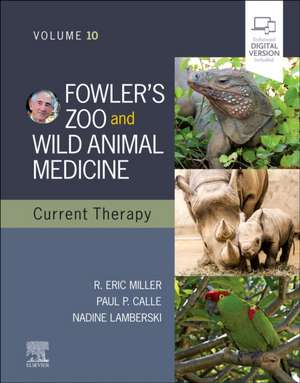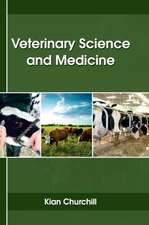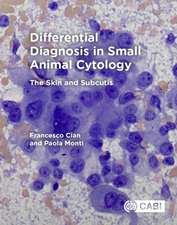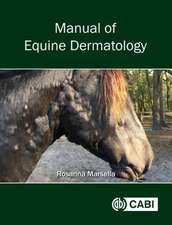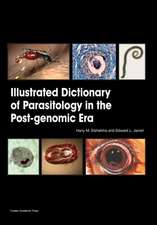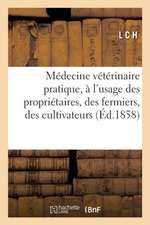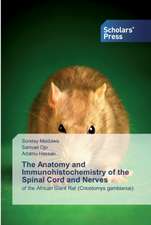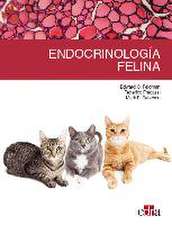Fowler's Zoo and Wild Animal Medicine Current Therapy, Volume 10
Editat de R. Eric Miller, Nadine Lamberski, Paul P Calleen Limba Engleză Hardback – 23 sep 2022
Preț: 946.91 lei
Preț vechi: 1244.45 lei
-24% Nou
Puncte Express: 1420
Preț estimativ în valută:
181.19€ • 189.68$ • 149.92£
181.19€ • 189.68$ • 149.92£
Carte disponibilă
Livrare economică 08-22 martie
Livrare express 01-07 martie pentru 333.04 lei
Preluare comenzi: 021 569.72.76
Specificații
ISBN-13: 9780323828529
ISBN-10: 0323828523
Pagini: 832
Ilustrații: 175 illustrations (175 in full color)
Dimensiuni: 216 x 276 x 32 mm
Greutate: 1.98 kg
Editura: Elsevier
ISBN-10: 0323828523
Pagini: 832
Ilustrații: 175 illustrations (175 in full color)
Dimensiuni: 216 x 276 x 32 mm
Greutate: 1.98 kg
Editura: Elsevier
Cuprins
ZAWAM 10 - Potential Topics
Final TOC forthcoming upon hand over; will be whittled down to fit 100 chapters from the 192 that are listed below.
- Leadership
- Update
- Risk-based quarantine
- Training programs in SE Asia
- Transferring veterinary techniques via training in developing countries
- Development of a regional wildlife health surveillance system
- Zoo and wildlife veterinarians as organizational leaders
- Diversity and Zoo and Wildlife Veterinarians
- Palm oil and wildlife health
- Alternatives to Annual Preventive Medical Examinations
- Application of pressure-sensitive walkway and gait analysis for lameness detection in zoo animals
- Use of near-infrared spectroscopy (NIRS) in zoo animal organs
- Use of ZIMS mega data
- ZIMS contributions to physical norms
- Recommendations for reintroductions
- Risk mitigation in reptile reintroducation programs
- Children's Zoo medicine and management
- Monitoring zoonoses
- Research study design
- Statistics for zoo and wildlife veterinarians
- Policy cooperation
- Geriatric Medicine
- Physical therapy for rehabilitating zoo animals
- Use of bio-loggers in wildlife medicine
- Common errors in understanding of tetrapod phylogeny
- End of Life decision processes
- Allometric monitoring of animal stress levels
- Designing an animal welfare questionnaire
- Review of animal welfare guidelines for zoos
- Veterinarians and the AZA Animal Welfare Guidelines
- Selected aspects of the Veterinary perspective on the implementation of zoo animal welfare
- An inexpensive way to monitor zoo animal welfare
- Complementary therapies for zoo medicine
- Approach to Orthopedic Surgery in Zoo Animals
- Approach to Minimal Invasive Surgery in Zoo Animals
- Pharmacokinetics
- Anesthesia monitoring
- Advantages of isofluorane vs. Sevofluorane
- Thiafentanil update
- Newer anesthetic combinations
- Use of local anesthesia in zoo species
- Avian analgesia
- Use of anxiolytics in zoo ruminants
- Anesthesia and hoof care
- Walkway to measure penguin gaits
- Use of radioisotopes to monitor feeding habits
- Effects of MRI on sea turtles and other species
- Use of Australian zoos and rehab centers to monitor for emerging diseases
- Development of a diagnostics lab in a developing country
- Infectious and parasitic diseases / emerging diseases
- CD in unusual species
- Cowpox in new species
- Yersinia in zoos
- Noninvasive monitoring of herpes viruses
- Hookworms and wildlife
- Migratory birds, tick-borne diseases and a changing climate
- Vaccination against TB
- Nipah virus
- Widespread disease in many species
- Integrated parasite management
- Larval drug sensitivity
- Brucella ceti in marine mammals
- Overview of Cl perfringens in zoo animals
- Leprosy as an emerging disease
- African Sine Fever
- Echinococcosis in zoo animals and wildlife
- One Health in the Arctic
- Effects of invasive Burmese pythons on the Everglades virus
- Yellow fever in South American primages
- Climate change in increasing wildlife and zoonotic infections in the Arctic
- Circumpolar Health
- Echinococcosis
- Development of an oral vaccine for white-nose disease in bats
- Semen banking for zoo vets
- Obstetrics & Gynecology in Zoo Mammals
- Assisted reproduction in reptiles
- Challenges in babirusa reproduction
- Pharmacology in invertebrates
- Staghorn coral reproduction
- Aquatic invertebrate medicine
- Antibiotic resistance in aquariums
- Assisted reproduction in endangered fish
- Fish neoplasia
- Fish medicine updates
- Harmful algal blooms
- Cane toad biology and eradication
- Veterinary input into amphibian Conservation programs
- Ultrasound of olmsteads
- Bd in salamanders
- Amphibian nutrition
- Amphibian pathology
- Medical aspects of a yellow-legged frog reintroduction
- Parannizziopsis australiensis in tuataras
- Snake implants techniques and safety
- Sea turtle topic
- Medical issues with Komodo dragons
- The effect of plastics (BPA, etc.) On reptile reproduction
- Effects of plastic contaminants on sea turtles
- New methods of reptile health assessment
- Parasites
- Current topics in reptile virology
- Sea turtle cold stunning
- Sea turtle rehabilitation
- Detection of Intranuclear Coccidiosis in turtles
- Firlavirus in reptiles
- Veterinary management of European pond turtle reintroductions
- Avian influenza
- Hemoparasites in raptors
- Veterinary input into sage grouse reintroductions
- Update on the status of vultures and NSAID regulations
- California condor program
- Pelican health
- Animal welfare and birds
- Bird flu in Asia Boripat
- Current thoughts on epidemiology of avian TB
- Avian analgesia
- Use of IV regional perfusion for treatment of avian foot infections
- Infectious diseases of Antarctic penguins - current and future threats
- Current thoughts on epidemiology of avian mycobacteriosis
- Avian neoplasia
- Philornis downsi and related species in birds
- African ground hornbill medicine
- Echidna nutrition
- Koala mortality
- Update on lumpyjaw in kangaroos
- Pangolin medicine
- Wildlife Reserves
- Pangolin confiscation medicine
- Medicine of giant armadillos
- Bat anesthesia
- Wildlife Trust
- Cardiomyopathy in fruit bats
- Small mammal
- Callitrichid preventive and general medicine
- IV anesthesia in great apes
- Training great apes for cardiac and physical exams
- Evaluation of the cause of death of gorillas in zoos
- Prosimian morbidity and mortality
- Veterinary Management of an orangutan rehabilitation center
- Granby gorilla, spider monkey, Callitrichid HSV1
- Orangutan respiratory disease
- Yellow fever and primates
- Ecology of brucellosis in Arctic carnivores
- Management of Persian leopards
- Treatment of alopecia in Andean bears
- Cheetah liver disease diagnosis and treatment update
- Medicine of fossa (or seasonal dermatopathy in Fossa)
- Instituting a rabies control program in Ethiopia
- Veterinary medicine in the rehab of "dancing" bears in India
- Polar bear SSP Research program
- Black footed ferret program
- Maned wolf
- Arthritis in big cats
- Urine as a monitor of large carnivore health
- Mystic Aquarium Marine
- Dugong medicine
- Large whale euthanasia
- What can be learned from marine mammal strandings?
- Dolphin urolithiasis
- Sea otter
- Dental issues in marine mammals
- Dolphin lungworms
- Brucella in marine mammals
- Giraffe contraception
- Giraffe skin disease
- Pigmy hippo
- Wildlife/livestock interface in Kenya
- Ruminant intensive care
- TB in wild cape buffalo
- Lameness diagnosis in hoofstock
- Takin disease
- Giraffe foot problems
- Game farm management of white rhinoceroses
- Rhinoceros birth parameters
- Browsing rhinoceroses and iron storage disease - an update
- Care for orphaned rhinoceroses
- White rhino diet-induced infertility
- Enteroliths in equids
- Tapir disease update
- Development of an oral speculum for elephants
- EEHV diagnosis update
- Update on EEHV in Asia
- Use of corrective shoes in elephants
- Vital signs and parameters for newborn elephants
- AI in elephants
- Tusk fractures
- Elephant foot health and sand substrate
- Recommendations for elephant herds
- Proteome
- Micribiome
- Metabolomics
- Madagascar
